This is a crosspost from City Observatory, the new think tank about urban policy led by Portland-based economist Joe Cortright. Many BikePortland readers will know Cortright as one of the loudest critics of the defunct Columbia River Crossing freeway expansion plan.
— by Joe Cortright
For the past several months, Portland’s City Council has been wrestling with various proposals to raise additional funds to pay for maintaining and improving city streets. After considering a range of ideas, including fees on households and businesses, a progressive income tax, and a kind of Rube Goldberg income tax pro-rated to average gasoline consumption, the council has apparently thrown up its hands on designing its own solution.
The plan now is for the street fee solution to be laid at the feet of Portland voters in the form of a civic multiple choice test: Do you want to pay for streets with a monthly household street fee, a higher gas tax, a property tax, an income tax or something else entirely?
Given voter antipathy of taxes of any kind, it’s likely that “none of the above” would win in a landslide if it’s included as an option on the ballot.
All of these options have their own merits and problems, and it’s doubtful that there is a majority consensus for any one of them. How, how much, and who pays for streets is a key issue for every city. From an urbanist and public finance perspective, and as a guide to thinking about which—if any—of these approaches Portland should adopt, here are my eight suggested rules for paying for streets:
1. Don’t tax houses to subsidize cars.
Despite mythology to the contrary, cars don’t come close to paying for the cost of the transportation system. The Tax Foundation estimates that nationally, only 30 percent of the cost of roads is covered by user fees like the gas tax. Not only do cars get a free ride when it comes to covering the cost of public services—unlike homes, they’re exempt from the property tax—but we tax houses and businesses to pay for car-related costs. Here are three quick examples: While half of storm runoff is from streets, driveways and parking lots, cars aren’t charged anything for stormwater—but houses are. A big share of the fire department’s calls involve responding to car crashes—and cars pay nothing toward fire department costs. Similarly, the police department spends a significant amount of its energy enforcing traffic laws—this cost is borne largely by property taxes—which houses pay, but cars don’t. If we need more money for streets, it ought to be charged on cars.
Adding a further charge on houses to subsidize car travel only worsens a situation in which those who don’t own cars subsidize those who do. One in seven Portland households doesn’t own a car, and because they generally have lower incomes than car owners, fees tied to housing redistribute income from the poor to the rich.
2. End socialism for private car storage in the public right of way.
Except for downtown and a few close-in neighborhoods, we allow cars to convert public property to private use for unlimited free car storage. Not asking those who use this public resource to contribute to the cost of its construction and upkeep makes no sense and ultimately subsidizes car ownership and driving. This subsidy makes traffic worse and unfortunately—but understandably—makes it harder and more expensive to build more housing in the city’s walkable, accessible neighborhoods. If, as parking expert Don Shoup has suggested, we asked those who use the streets for overnight car storage to pay for the privilege, we’d go a long way in reducing the city’s transportation budget shortfall—plus, we’d make the city more livable. We should learn from the city’s success in reforming parking for people with disabilities that getting the prices right makes the whole system work better.
3. Reward behavior that makes the transportation system work better for everyone.
Paying for the transportation system isn’t just about raising revenue—it should be about providing strong incentives for people to live, work and travel in ways that make the transportation system work better and make the city more livable. Those who bike, walk, use transit, and who don’t own cars (or own fewer cars) actually make the street system work better for the people who do own and use cars. We ought to structure our user fee system to encourage these car-free modes of transportation, and provide a financial reward to those who drive less. The problem with a flat-household fee or an income tax is it provides no incentive for people to change their behavior in a way that creates benefits for everyone.
Advertisement
4. Prioritize maintenance.
There’s a very strong argument that we shouldn’t let streets deteriorate to the point where they require costly replacement. Filling potholes and periodically re-surfacing existing streets to protect the huge investment we’ve already made should always be the top priority. Sadly, this kind of routine maintenance takes a back seat to politically sexier proposals to expand capacity. We need an ironclad “fix it first” philosophy. Also, we need to guard against “scope creep” in maintenance. There’s a tendency, once a “repair” project gets moving, to opt for the most expensive solution (see bridges: Sellwood, Columbia River Crossing). That’s great if your project gets funded, but a few gold-plated replacements drain money that could produce much more benefit if spread widely. We need to insist on lean, cost-effective maintenance.
5. Don’t play “bait and switch” by bonding revenue to pay for shiny, big projects.
There’s an unfortunate and growing tendency for those in the transportation world to play bait-and-switch with maintenance needs. They’ll tell us about the big maintenance backlog to justify tax and fee increases. Then they bond two or three decades worth of future revenue to pay for a shiny new project; the Sellwood Bridge and the local share of the Portland-Milwaukie light rail have been funded largely by tying up the increase in state gas tax revenue, vehicle registration fees, and flexible federal funds for the next two decades. The state, which routinely financed construction on a pay-as-you-go basis, has also maxed out its credit card: in 2002 ODOT spent less than 2% of its state revenue on debt service; today, it spends 35%. Now it is pleading poverty on highway maintenance. Politically, this makes a huge amount of sense. You get to build the projects today, and pass the costs into the future. Unfortunately, in practice it leads to a few gold-plated projects now, while jeopardizing the financial viability of the transportation system in the long run.
6. Promote fairness through the “user pays” principle.
We all want the system to be “fair.” In the case of general taxes, we often put a priority on progressivity—that taxes ought to be geared toward ability to pay. But for something like transportation (as with water rates, sewer rates, or parking meter charges), fairness is best achieved by tying the cost to the amount of use, or what economists call the “benefit principle.” Charges tied to use are fair for two important reasons: higher income people tend to use (in this case, drive) more than others, and therefore will end up paying more. Also, charges tied to use enable people to lower the amount they pay by changing their behavior.
7. Don’t buy the phony safety card.
We’ll hear all about the need to spend money to make our streets safer. The safety argument is an all-purpose smokescreen to justify almost any expenditure, no matter how distantly related to safety. (Ostensibly, the $3.5 billion Columbia River Crossing project was justified as a “safety” project, even though the I-5 bridge had a lower crash rate than the Fremont Bridge). Here’s the key fact of street safety: Smaller, slower streets are safer. Metro’s region-wide analysis of crash data showed that fast-moving, multi-lane arterials are by far the most dangerous streets in the region for cars, cyclists, and pedestrians. The more we get people out of cars, the more crashes and injuries decline. The most effective thing we can do to improve safety turns out to be the cheapest: implement features that slow and calm traffic, and make walking, cycling, and transit more attractive.
Commissioner Steve Novick points out correctly that his proposal contains a specific list of laudable safety projects that he proposes undertaking with street fee proceeds if his proposal is adopted. These projects don’t fall into the “phony safety” category outlined above. Still, voters should consider two other things. First, while the proposed list is a good one, it is “preliminary and subject to change” and isn’t binding on future city commissions, and the “safety” category is an elastic one. Safety projects are defined as those that “reduce the likelihood of a person being killed or injured and address the perception of risk.” Second, transportation money is very fungible. Its always possible to re-arrange the budget to tell someone that this “new” money is only being used for good purposes. The larger question is the overall priorities for the entire transportation budget. If safety spending out of current revenues is reduced, the net gain could be less than advertised.
8. Don’t write off the gas tax yet.
There’s a widely repeated shibboleth that more fuel-efficient vehicles have made the gas tax obsolete. Despite its shortcomings as a revenue source—chiefly that it bears no relationship to the time of day or roadway that drivers use—there’s nothing wrong with the gas tax as a way to finance street maintenance that a higher tax rate wouldn’t solve. While other methods like a vehicle-miles-traveled fee make a lot of sense, the reason they’re popular with the transportation crowd is because they would be set high enough to raise more money. And there’s the rub: people are opposed to the gas tax not because of what is taxed, but because of how much they have to pay. As an incremental solution to our maintenance funding shortfall, there’s a lot to like about a higher gas tax: it requires no new administrative structure, it’s crudely proportionate to use, and it provides some incentives for better use of streets. So when very serious people gravely intone that the gas tax is “obsolete” or “politically impossible”—you should know what they’re really saying is that people simply don’t want to pay more for streets.
Transportation and urban livability are closely intertwined. Over the past few decades it has become apparent that building our cities to cater to the needs of car traffic have produced lower levels of livability. There are good reasons to believe that throwing more money at the existing system of building and operating streets will do little to make city life better. How we choose to pay for our street system can play an important role in shaping the future of our city. As Portlanders weigh the different proposals for a street fee in the coming months, they should keep that thought at the top of their minds.
Joe Cortright is an economist and director of City Observatory, an urban-focused think tank supported by Knight Foundation and based in Portland, Oregon.





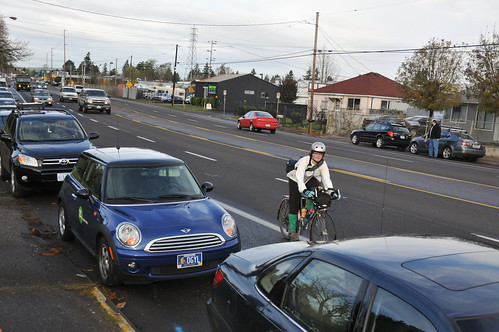
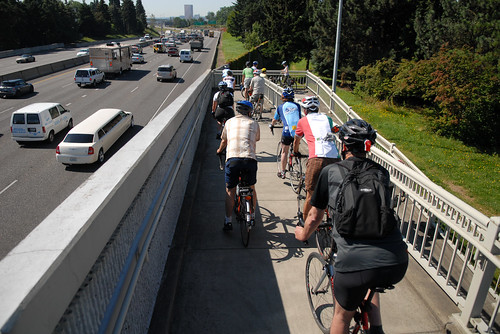
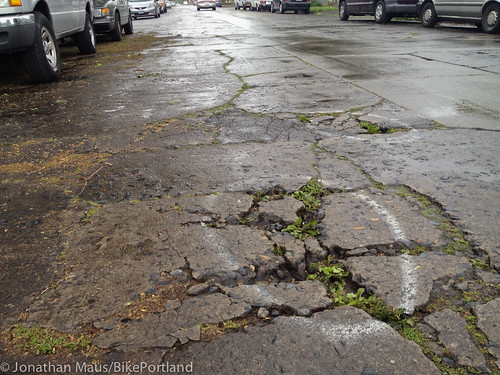
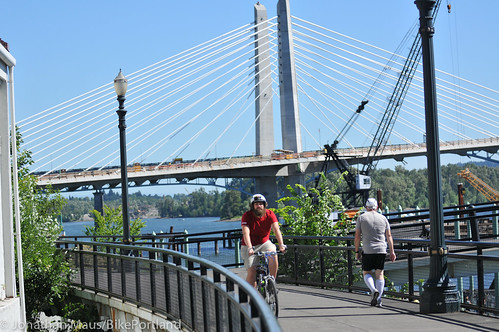
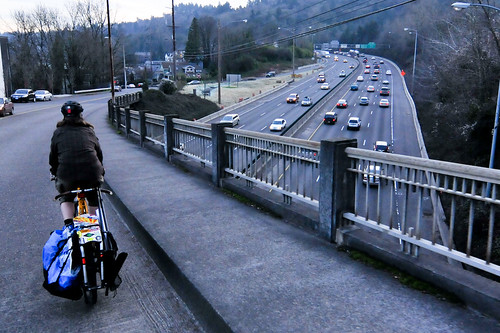
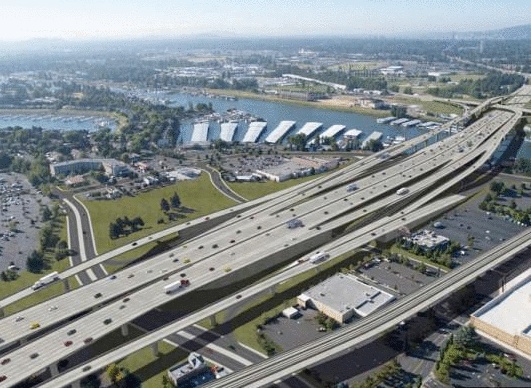
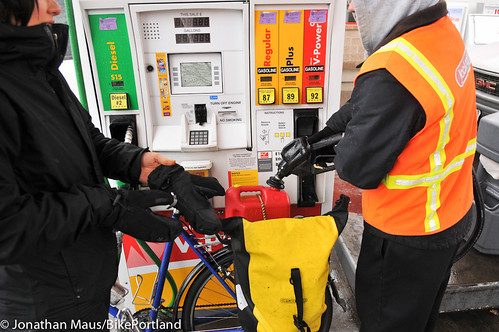
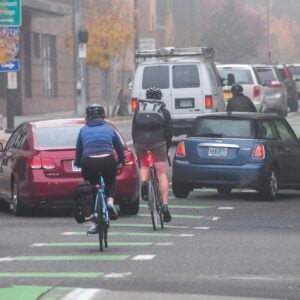

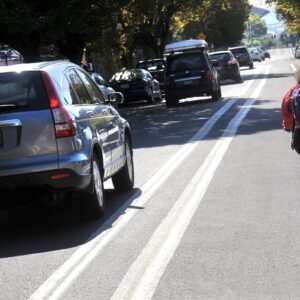

Thanks for reading.
BikePortland has served this community with independent community journalism since 2005. We rely on subscriptions from readers like you to survive. Your financial support is vital in keeping this valuable resource alive and well.
Please subscribe today to strengthen and expand our work.
Great write-up. If we want to move forward as a society, we have to disincentivize automobile use and promote walking and biking. This can only be done by heavily taxing car drivers and using the money to make walking and biking safer. The social cost that the car has placed on city livability should no longer be tolerated.
I agree with you in most situations, however, there are still some scenarios where a car is the best solution for the individual and should not be made so expensive that low income individuals who work two+ jobs where they can find them cannot afford the necessary travel. There is still a good deal of economic stress on lower income families and finding jobs is challenging for most people.
Socially responsible transportation is important, but employment, wherever it may be, is still a crucial element to survival.
You raise a good point, although I’d argue that it’s not solely the car that puts the burden on low-income families, but the fact that cities have been built to be more spread out to require a car for daily life — especially in low-income neighborhoods. This can be mitigated by using car tax funds to build out better transit to poorly-served areas.
In addition, I would definitely be in favor of waiving taxes for low-income families that are already struggling with the high cost of car ownership.
I think that would be a good, rounded solution for both sides.
Cars are often the best solution in these situations due to a lack of public transportation and limits on low income housing (close to places of employment). Even progressive gas subsidies would indirectly subsidize these socioeconomic trends. I personally cannot support a gas tax increase that does not allocate substantial revenue to public transport.
Agreed, but perhaps it should be in the form of an individual subsidy based on income rather than the blanket subsidy which exists today. The objective is to maintain the right of way for everyone equitably.
Part of what makes it so great to me is that Cortright doesn’t come across as patronizingly anti-car.
Part of what makes it so great to me is that Cortright comes across as anti-car.
Well said. You took my point.
I think this is the most concise and detailed critique of the situation we’re in and the approach taken by the city to appear on bikeportland. Wow. Thanks for reproducing it here!
I think we also need to factor in the productivity that automobile use helps create, also.
It’s easy to focus on just costs.
Oh so Tax cars?
here is how you do it.
http://taxes.arlingtonva.us/vehicles/vehicle-taxes/
That’s one way, although it incentivizes keeping “beaters” that have low value but may be much more polluting. But then it also incentivizes getting rid of a car altogether…
Many of the proposals floated by city hall shared a single massive flaw, they didn’t impact commuters who choose to live outside Portland and work in Portland. We don’t need more subsidies for commuters.
Outside of tolls how do you fix that loophole though? (and we all know tolls are massively unpopular). Sales tax?
I think support would be for the gas tax in this situation, assuming that the commuter will atleast intermitently buy gas from a station within city limits
I commute to Portland by bus. The only time I predictably have to buy gas in Oregon, is when vacationing in Oregon, or on the way to another state. I suspect most people could easily shift to purchasing gas near their home. I know the gas near my home is some of the least expensive in the region (Chevron).
I’m more in favor a gas tax myself, but that is likely not to get much of the out of Portland commuter traffic.
Wow, sorry. “That is likely to not get much of the out of Portland commuter traffic”
All taxes are unpopular, but they are required for a functioning society.
Actually, the ‘Tax the Other Guy’ tax is wildly popular.
Simple, raise the money by charging a market rate for publically owned on street parking and taxing parking lots.
plenty of places have their own private lots though.
yeah, that is why I said tax parking lots.
marijuana tax after July? I’m fine with direct user based taxes but I’m personally tired of my property tax increasing so dramatically to help every special interest out there. I drive about 8K miles a year, mostly all on roads outside of the PDX area. The thought of taxing my house ~$200 more per year (with no termination date) to pay for everyone else’s road damage is seriously making me consider a relocation to a more sensible city/town. The system of government in this place is really mental to the point of absurdity.
A cannabis tax would have to be state mandated – local taxes aren’t allowed.
Charging for parking, gas tax, congestion tolling, speed cameras, red light cameras.
INCOME TAX . . .if a worker’s legal tax address is outside Portland city limits, you pay a 1.5% ??? additional income tax allocated to transportation maintenance.
Many cities with the majority of a “metro” population in the suburbs have systems that are similar to this approach. (see St. Louis, MO)
AND it is simple to implement. Just add this to the accounting payroll tax withholding.
People from WA would likely freak out (as they’re already paying a sizable income tax to OR).
Ah, but they don’t vote in OR, so it won’t matter if they do.
And that’s one of their biggest grips. “Taxation without representation”
I assume you meant, “…and their worksite address is INSIDE Portland city limits, and it can be determined that they drive to the office every day rather than telecommute or drive to client sites outside of Portland…”
Doesn’t seem like author answered the question in the headline.
Just pointed out a bunch of things for voters to consider, but no proposal was floated that would take those into account.
Not explicitly, but it’s pretty clear he favors raising the gas tax and charging for parking.
A quick note about on-street parking – It is often something that we urban planners want to encourage because it provides a safety barrier between people on the sidewalk and the rolling boxes of kinetic energy on the roadway.
Glen,
I’ve heard that from planners and engineers too. And I think it’s absurd. Sorry for using that word, but really… Please tell me that you understand why that logic is off-base.
It’s like.. Planners realize the negative impact of the presence of cars — both in terms of their potential for physical harm and how they detract from the quality of a place, yet they are OK with making the use of cars even more attractive and viable by offering up such convenient parking? And remember those people whose cars are making a “safety buffer” eventually drive away and become a safety problem.
Surely your profession can dream up a better way to keep streets safe and pleasant than to give free parking to people’s cars.
“making the use of cars even more attractive and viable by offering up such convenient parking?”
But you are basing your opinion on this logic, which many would disagree with.
I see Glen’s point. People fall off curbs all the time. Little kids have been known to run into traffic. Having essentially a “fence” of cars there isn’t always the worst thing in the world. I agree that I don’t want it to be taking away from actual transportation space (as we’re seeing a lot of in Portland), but a parking strip is not inherently evil.
I hear you. .. But that just sounds so Portland to me. We should be doing great things, we CAN be doing great things… But too often we are settling for “isn’t the worst thing in the world.”
Bottom line is: A truly great city does not have policy or planning practice that encourages driving or makes it easier to do in crowded commercial/urban areas. Not in any way, shape, or form.
Storefront->Sidewalk->Bike Path->Bioswale->Traffic Lane.
There, now everybody’s safe. Seems easy.
That’s one solution – space between aggressive and vulnerable users. Barriers are another, and come in two forms, permeable and impermeable. parked cars, curbs, poles hedges, swales are permeable. walls, guard rail, jersey barriers are less permeable. Such barriers might be necessary, but they are only treatments for symptoms of the actual problem (planned or in error). The problem is the speed of motorists mixed next to vulnerable road users.
Portland should start from a low speed design paradigm and invest as needed where motor vehicle mobility desires are higher.
I don’t oppose on street parking, I oppose “fareless” on street parking. The problem isn’t the parking, it is the subsidy.
Aw man, you’re bringing up bad memories of the 20’s bikeway. That city wimpout still makes me angry. Then they had the gumption to propose narrowing the sidewalks north of Sandy to keep Katie O’Brien’s parking. Grrrr. That plus the CRC, plus the parking minimums made me wonder what Portland was smoking. I keep expecting the CRC to rise from the dead again like the killer in a bad slasher film.
But it’s not a permanent barrier. What dangerous ridge has a guardrail that develops gaps at random intervals, as happens when cars drive away from a parking strip? If a barrier is desired for safety, and that truly is the intent, then it seems a permanent structure would be more desirable.
Jonathan, Glen’s profession doesn’t need to “dream up” anything. There are plenty of countries, states and cities around the world who have already figured this out. No need to reinvent the wheel here.
Thanks Jonathan, I was in the middle of responding… absurd is right… Plus the safety barrier simply doesn’t work. Cars repeatedly literally fly into storefronts on a regular basis. How about making cars simply drive around your urban plaza where pedestrians congregate?
or… Storefront->Sidewalk->Bike Path->Bioswale->Traffic
writing this makes me furious about the design of Director Park too… those traffic lanes are SO DUMB. just drive around.
Urban Planners need to take their cities back.
If it is a regular basis, then what are the intervals?
Multiple times every day in America.
With a regular, predictable measurement of time in between each occurrence?
It’s an intermittent basis, not a regular one.
I think the intended meaning was “frequently”.
Where I live (on SE 12th) parked cars on both sides are also an impenetrable *visual* barrier. It is very difficult to see traffic when driving across 11th or 12th, and virtually impossible to see a cyclist riding close to the parked cars. I’d guess that hazard (which has resulted in at least one recent motorcycle fatality) negates most of the safety benefits of the raw mass of those cars. When you add in all the safety features that have been given up in the name of preserving street parking (a safer Hawthorne lane pattern, bike lanes or spaces all over town, etc.) it starts to log a lot more like a safety bug than a feature.
Also, don’t promote an impractical, expensive-to-administer option because it is politically feasible.
some other ideas:
Studded tire permit sticker: must be displayed to use studs on City streets
Vehicle registration fees increased proportional to vehicle weight
Increased DEQ fees based on miles driven since last check
New tax on surface parking lots (in addition to City-wide parking stickers)
Heavier vehicles, in general, are less fuel efficient, so would use more gas and pay more tax.
OK, but isn’t fuel consumption roughly linear with weight, while road wear per weight is fourth power?
Heavy haul trucks already pay a weight-mile tax.
Once again, Joe Cortright has nailed it.
In past decades 4 and 5 have basically been the same thing though in Portland. Rolling large portions of the budget into funding street car and other programs (in addition to a myriad of other debatable “wasteful” projects) has dropped the maintenance funds.
I would argue though with the last paragraph (re: catering to cars = lower livability). For MANY Portlanders there is a tipping point of taking away too much from cars (or making driving so difficult) that they will view it as decreasing their livability (many will likely argue this about on street parking too).
As usual, I see no suggestions concerning a small bicycle registration fee. Say $20 a year? Not much, but it would help to pay for bike lanes and maintenance, and bikes being registered would help the cops with theft recovery.
Many studies have shown that a small bicycle fee would actually cost more to collect that it would make in fees.
See: http://www.seattlebikeblog.com/2013/02/21/why-a-statewide-bike-tax-makes-no-sense/
Then it needs to be larger to offset the administrative costs.
?
Administering and enforcing a bicycle registration program would cost so much, there’d be little revenue left over, if any.
For a moment I thought you were talking about the Street Fee.
“but it would help to pay for bike lanes and maintenance”
except that
(a) people who eschew the car and bike for transportation typically overpay* relative to the damages their transportation choices inflict, and
(b) the only reason we need bike lanes is because of the overwhelming and dangerous presence of the automobile on our streets.
*Todd Litman, Whose Roads
I don’t drive, but I pay state taxes, and since only 30% of road projects are funded by the gas tax, I am already paying for bike lanes and maintenance.
I think you need to consider that the cycling infrastructure is usually done in conjunction with road projects to leverage the construction costs of the cycling infrastructure
Stand alone cycling facilities would cost more than they do now…..so your assumption that your contributions now would cover the new funding model is spurious.
Standalone cycling facilities would not be necessary if not for dangerous drivers of cars. Those who cause the problem should be the ones who pay extra to fix it or mitigate it.
I own a car and pay taxes/fees but only drive it 200-400 miles a year.
Soren, if that’s all you drive, then why do you own? I drive more than that for recreation per year, but I still found that renting vs. owning is basically a wash, so I sold my car. Now, I have no worries about finding my windows smashed one day or having a sudden and costly repair come out of the blue.
The occasional utility of having to travel a longer distance (in a short period of time) for work. And while I realize renting is somewhat cheaper, it’s less convenient.
Not directly discussed by Joe is the burden car use places on other legitimate roadway users. Pedestrians and cyclists have as much right to use the public rights of way as motor vehicle operators, however those motor vehicle operators externalize most of the risk of injury to non-motorized users. It is just and moral that motor vehicle users assume responsibility for thier choices, and that the costs to permit them to travel at higher speeds, by making the rights of way as safe for non-motorist use, be shouldered primarily by motor vehicle operators. If the cars were not on the streets, the injury and fatals would drop dramatically.
Very nicely said. Thanks.
“As usual” because its a vetted idea with no chance at being profitable. but I’m guessing $20/year would shut up the haters..
in that line of thinking, pedestrians should be asked to pay for sidewalks and crosswalks as well, right?
Awesome. Well reasoned arguments. However, I’ll quibble with this statement: “We all want the system to be ‘fair.’” As a mixed-mode household (one of us bikes, one drives), the approaches suggested seem very fair to me. But we all know what the reception from much of the driving community will be (is already) to the kinds of things suggested in #2 and #3. The same people who want bikes to “pay their fair share” for roads see things very differently when confronted with the actual data showing they should actually pay more. There’s been much discussion on this site related to the costs of studded tires, for example. That’s of course the challenge to this kind of (accurate) thinking. I’d vote for a plan following these principles, though.
Nice points. I’m just waiting for the Portland Business Alliance and the greater freight “community” to offer their full-throated support towards a cordon pricing scheme that disincentivizes driving downtown during peak commute times. After all, it’s not bicycles that delay freight deliveries, it’s the 70 percent of the population that chooses to drive in a single occupant vehicle.
how about we tax things that make driving less desirable, so less people drive if they could bike, and less damage to roads, not to mention the innumerable benefits that come with less cars on the road. Anything but a gas tax, or other direct tax on drivers makes no sense.
Great piece! I am better for having read it. Thought it is not anti-car at all, I submit that being anti-car is needed to balance out our very cars-are-free conversation.
There is nothing wrong with being anti-car. Cars are bad for society in many ways – including, but not limited to: they pollute, they crash into people, and they take up a lot of space that could be better used for people. Cars certainly have their place, but they should be given free reign over the city, to the detriment of others not in cars.
In my opinion, being pro-livability requires being anti-car. The two ideologies are not compatible.
Good stuff Mr. Cortright. I think you are spot on with the exception of #8. No I don’t think the gas tax is necessarily obsolete, but it is a crude tool. If we are making a wish list, why not go big? To improve on it, I suggest two simultaneous fees:
1 Carbon tax. This encourages innovation in ways that benefit a lot more than just ODOT.
2 Vehicle mile tax that is a function of distance and – critically – weight. (And a major fee for studded tire installation/purchase.) As an almost-always-cyclist, I’d even pay a user fee on the same scale. (My 30lb bike probably wouldn’t add up to much compared to the semi I am currently forced to pay for.) New vehicles all have GPS and communications that would make the collection and calculation a snap. (Wah privacy – autoamkers are selling that data already, why not use it for good?)
These two fees much more effectively charge according to use, more fairly funding roads according to use AND nudging behavior toward the positive things you highlight above.
E cars would get a benefit commensurate with the improvements they provide to society but not totally off the hood in paying for the roads they still require.
Cyclists and pedestrians would still fund their amenities with property taxes and we’d all be better off.
Nice summary, but a couple of quibbles:
The Interstate Bridge probably has good stats because (during peak hrs) the cars cant go fast enough to cause a “decent” wreck, and as for the safety canard, some of those shiny objects will probably be useful after the big quake… Where the existing bridges may not.
We, and our beleaguered leaders are reaping the fruits of the inability to make hard long-term decisions, which is the purpose of government.
Time for a bike ride.
Can someone turn this into a petition to send to city council?
As much as I support raising funds for a better transportation system (and will happily pay my share!), I will absolutely vote “none of the above” if the only options refuse to acknowledge the massive subsidy provided for private automobile use and storage.
Joe, THANKS SO MUCH, There’s really nothing more to say, you said it ALL.
RAISE THE GAS TAX! PRONTO
Joe for Mayor! He nailed this!
I’d like to offer up some additional thoughts on Joe’s point #2 (free parking) in the form of a blog post I wrote last Fall:
http://fatpencilstudio.com/free-parking/
If you click over to the article, you’ll see two color coded maps comparing land value with parking fees. Land values are higher in the central areas where we charge for parking. But if you add up the value of the land in the rest of the city where parking fees are zero, its a huge giveaway.
Asking people to pay for free parking is a difficult political move (and the article explains why)… but it is a logical one.
I second all the kudos above for Joe’s clear and well written piece.
One peripheral note, however: As highly as I think of City Observatory’s mission, the orange on orange design of their site made it really hard for me to read the article. I spent half an hour fiddling with Readability and Clearly, but no luck on a mobile platform. It was good to find the article reprinted here on BP, which is much more accessibility-friendly.
raising the gas tax while gas prices are low will help scale future income from it more appropriately
also, perhaps someone clarify why there needs to be a public vote to raise the gas tax? i thought this was under the powers the state already had.
I believe the gas tax could be raised with a vote of the appropriate elected officials, but they fear it being overturned by the initiative process. That’s why they often choose to refer it to the voters.
Wait, what?
I usually agree with much of Cortright’s analysis, and most of what he suggests here is no exception, but this is a bit intellectually lazy and he starts to go way off the rails with numbers 4 and 5.
‘We need an ironclad “fix it first” philosophy.’
Well, anytime ‘ironclad’ philosophies are suggested your alarm bells should go off. Fix what first? And what other projects are we deferring to fix ‘it.’ Our priorities should be based on both a cold-hearted cost-benefit perspective, but also with an eye on equity. Do we really need to fix the pothole on my relatively well-to-do street before we put a safe crossing across SE 122nd? Transportation spending priorities are not so simple as ‘ironclad’ philosophies. It’s about decisions and trade-offs, and a complex variety of factors must be considered.
Further, the notion that we shouldn’t prioritize ‘shiny objects’ like the Tillikum Crossing pictured is foolish and unambitious. This project (and others that we’ve bonded) are worthwhile investments in our region that will reduce car travel, spur favorable development patterns, and pay off in a variety of other ways. How does the cost/benefit of this compare to that of fog-sealing a lane-mile of Powell? That’s a difficult question that your ironclad philosophy won’t answer, but precisely the kind of question that we must answer to correctly spend our limited resources. Also, ODOT’s debt percentage has positively nothing to do with either bridge replacement. Talk about bait and switch.
Also, we need to collectively get over the notion that a higher gas tax is a solution to our problems. A gas tax hike, at least a the local level, is the transportation funding equivalent of the Versailles Treaty. It’d take a bloody, drawn-out fight to provide little more than a short-term respite from the deeper, more structural problems. (I fully support gas tax hikes at the state and national levels as part of a comprehensive funding package, however, but changing travel patterns coupled with tech will reduce gas tax revenues dramatically over the next 20 years).
As I like to say, funding a multi-modal transportation system with a gas tax is like funding a methadone clinic with a tax on heroin–providing the solution depends upon the continuing severity of the problem. Every nation that we hold up as a transportation model has a two-part funding mechanism: a (high) gas tax which disincentivizes car travel and provides fairness by taxing higher-impact uses accordingly, and an income element to provide the necessary balance. That’s what we should be after too.
“but changing travel patterns coupled with tech will reduce gas tax revenues dramatically over the next 20 years).”
Is this a big deal if the Street Fee (as currently proposed) is likely to sunset in 5-10 years? If we get the money we need in 10 years with a gas tax, is declining gas tax revenue a big deal (remember PBOT has other funding sources (which they could be using more productively/smarter)?
It’s bit disingenuous to say we should stop subsidizing car parking, when all bike parking (in the public right of way) is free. In many places cars pay to park, but I have yet to see a meter for bike parking.
As for ‘Promote fairness through the “user pays” principle.’ I think it is a great idea. All those bike lanes – user pays. All the green boxes – user pays. All the bike paths and infrastructure – user pays. By your own recommendation bikes should have a user fee. It’s only fair if you want to tax cars for those nice paved surfaces you should also tax bikes for their share. So far all that dedicated infrastructure cost the people who use it absolutely nothing.
I ride a bike to work sometimes and drive a car sometimes, so I get both benefits. You can’t pretend that one isn’t paying the fair share and the other is, when the bike share of the taxes is zero. So you are really arguing that you want a subsidy at the expense of others.
Then again, I am glad I live in Clackamas County and avoid the Portland nonsense altogether. Thanks for the new bridges! 😉
“All those bike lanes – user pays”
…except that we’re trying to encourage bicycling and discourage driving. So refusing to use the financial tools at our disposal makes no sense.
“It’s only fair if you want to tax cars for those nice paved surfaces you should also tax bikes for their share.”
…except that bikes don’t cause any deterioration, don’t require smooth surfaces. All they need is to be left alone by all those cars zipping around.
car user fees only pay for a portion of those roads so people like me who do not drive much subsidize those who do.
Pretty sure if the bike lanes were lumpy/bumpy mud lanes, you’d have a lot of unhappy cyclists… So yes, they do need to be smooth /maintained surfaces…
I’m not that fond of the paint stripe “bike lane”, applied when there is not enough room for the free car parking. It encourages motorists to buzz me.
You compare a bike locked to a pole to an appliance the size of a dumpster stored at no charge in the public right-of-way?
Every mile we drive is government subsidized. Every mile biked saves tax money. The math is easy.
It’s bit disingenuous to say we should stop subsidizing car parking, when all bike parking (in the public right of way) is free.
http://trimet.org/howtoride/bikes/lockersavailable.htm
You can’t pretend that one isn’t paying the fair share and the other is, when the bike share of the taxes is zero.
You didn’t read the link to The Tax Foundation in Cortright’s article or you wouldn’t say that. 70% of the cost of roads are paid for by fees not related to driving (non-user fees) – https://www.portlandoregon.gov/transportation/article/421323 . I’ve collected a few more references to help you understand how roads are funded here – http://bikeportland.org/forum/showthread.php?t=3785 .
and i personally am glad that i live in portland where more people realize there is no such thing as a free lunch when it comes to functioning infrastructure. moreover, i strongly believe we should toll mooching clackamas county residents who use our infrastructure but refuse to pay their fair share.
why stop there? every surrounding county and state uses PDX roads and infrastructure regularly. they’re not being asked to pay for it in the least. I think Portlanders realize their taxes are being used inappropriately for things that were not intended (Sellwood Bridge, water bureau expenditures, etc). Time and time again independent audits have shown our City Counsel abusing their appropriations, but yet you still stand being them and want to give them $40M MORE dollars to misuse?
I’m willing to pay for SECURE bike parking, and I currently do, at a rate of $15 month, even when I’m not using it. Put up more lockers around town that I can pay to use, and I’ll use those too.
While I agree with Cortright on most of his issue, I disagree with him on others. Pointing to the Sellwood Bridge as an “expensive solution” ignores the fact that it is well beyond its functional life, has been deteriorated due to a slow-moving landslide on the west end, and was abysmal with regard to its ability to accommodate bicyclists and pedestrians. Has he ever ridden a bike over that bridge? I’d guess not.
The bridge could have been made cheaper by eliminating the ODOT-required interchange at the west end where it intersects OR 43, but then again, we could have provided a single, 10- or 12-foot wide shared-use path for bicyclists and pedestrians. That would have satisfied Cortright’s build-it-cheaply preference. Does anyone really like the path in the center of the I-205 Glen Jackson Bridge?
Agreed. I am very interested in his complaints re the Sellwood. It had to be replaced and appears to me it’s being replaced with a sensible bridge. Building a brand new bridge without high-quality bike/ped features would arguably be a bigger waste of money. Is he quibbling with aesthetic features? To me those are a modest and worthwhile investment. And lastly, that’s a piece of infra actually paid for by user fees!
I am biased as a heavy user, though. So like I said, I’d genuinely like to hear his side on that one.
I like Joe’s points, and I would like to see some acknowledgement that non-drivers also rely on the street system. Even folks who stay home most of the time use the streets when they get their mail delivered, or their Amazon packages, or call a plumber, or use the internet as their ISP or cell service depends on the streets to string their wires or hang their antennas. And of course, as a bike commuter I rely on a well-maintained street system.
I support significantly higher gas taxes both to pay for transportation infrastructure and to better protect the climate. And I think the best way to discourage driving is not to tax it, but to make it less convenient through increased congestion and expensive parking. That’s what keeps me from driving when I go downtown.
“Even folks who stay home most of the time use the streets when they get their mail delivered, or their Amazon packages, or call a plumber, or use the internet as their ISP or cell service depends on the streets to string their wires or hang their antennas.”
…but a gas tax takes account of all this, because everyone who is providing those services pays those gas taxes and—if they’re paying attention—will pass along those costs to their customers. What more acknowledgement would you think appropriate?
If deliveries are by drone or cyclists, then gas taxes won’t cut it/arent applicable. Need to tax all modes of transportation…
If deliveries are made by bicycle—as you are suggesting—I’m not understanding why forgoing the tax revenue (that a motorized alternative would have yielded) is a problem. Isn’t this what we’re striving for? If (all) deliveries were made by bicycle I dare say we could (all but) dispense with the need to keep fixing our roads (all the time). The roads could be narrower, thinner, and would last vastly longer.
…not sure about the drone suggestion.
Not saying forego taxing vehicles, bit tax bikes too…
But why? Why tax a specific mode of transportation which already pays more than its share? Why not tax the mode which underpays?
The Norwegian town of Lillestrøm went even further. For a week last July they paid people walking and bicycling—for eschewing the car and choosing a more environmentally salutary way of getting around. People on bikes got 12 euros, people walking 11 euros. The Norwegian ministry of health had calculated that the state saves six euro for every km walked and three euros for every km biked. Multiplied by the average length of a bike trip (4km) and distance walked (1.7km) yielded those figures.
http://green.wiwo.de/alternatives-mautkonzept-stadt-zahlt-geld-wenn-man-sein-auto-stehen-laesst/
Don’t forget that to be fair, (if you want people commuting to pay for transportation infrastructure in lieu of property taxes) that you also need to implement a walking tax and a cycling tax to pay for the walking and cycling portion of the infrastructure ;). So…. Toll sidewalks etc…
Taxes in Portland live/die based on how they’re paid. People don’t mind “pay as you go” taxes*. People *do* mind surprise taxes at the end of the year for hundreds of dollars (see: Multnomah County ITAX, the popular arts tax). EOY surprise taxes are always short lived. Nobody wants a surprise $350 bill at the end of the year, and another tax return to file.
Things like property tax increases, however, are almost always supported and usually renewed when they expire. That’s because it’s a little bit taken out each month, and people don’t really notice. I think there’s also this (incorrect) perception from some renters that they’re voting for a tax for someone else; so why not support it?
Also, gas prices are easy to compare (just look at the sign), and thus easier to complain about “those crazy high gas prices in Portland.” Property taxes, OTOH, are a lot more hidden and thus much harder to compare and complain about. Renters don’t even see the property tax bill, homeowners see it but have to basis of comparison.
Property taxes are a little bit taken out each month? If if you are paying your taxes with escrow it still is submitted in one large sum. And many people also pay their taxes in a lump sum straight up.
Given the city’s massive problem with property tax inequality, I don’t know if that’s the way to go right now. I know many people in my area (who are overtaxed in proportion to the rest of the city) are not very happy with the idea of more taxes on top of that.
You can create the most equitable tax in the world, but if people have to pay it at the end of the year with a separate tax return, then there will be a revolt — simply for the fact that they will be irritated by having to fill out yet another tax return, and then *feel* the cost because it’s paid all at once.
For a great example, see the Multnomah County ITAX. Everyone *HATED* that thing — no matter how much good it actually did. That’s also why the current street fee proposals are so unpopular.
I would like to know how we can implement a “user fee” system without implementing some sort of GPS in cars that tracks distance traveled within the city or state. That has already been shown to be a political non-starter. Do we tax mileage at re-registration? And I assume we adjust for vehicle weight, since heavier vehicles (especially trucks) cause a lot more damage. (And how are registration fees allocated to the state, county, and city?)
I’m genuinely asking because I agree completely with Cortright on user fees, but haven’t yet seen a feasible way to implement them.
Also, is it really possible via parking charges to collect sufficient funds to make a significant dent in the PDOT budget? In my own case, I can park my cars in my driveway, as can many in my particular neighborhood. And that makes this also very hard to get passed, because it hits very unevenly depending on the development pattern of where you live, and I suspect many in the inner neighborhoods are going to claim that they bought their house ten, twenty, or more years ago under a system where the city and the homeowner had shared responsibility for maintaining the sidewalks, parking strip, and right of way. No, I don’t do road maintenance for the city, but I do just about everything else.
I get the principled position, but foresee a huge groundswell of opposition from homeowners (55% of the population).
I just don’t see anything working politically other than the gas tax. And even Cortright’s article, as smart as it is, hurts the other options because it calls into question the long term spending priorities of the City, exactly the issue animating much of the opposition.
I can’t help it but I smell a rat in this Street fee deal. More money for any DOT, even Portland BOT, usually means more, smoother, faster roads. What’s the source of the data on the condition of our streets? I shared an office with the maintenance guy of the building where I worked for 10 years, and no disrespect intended, I think maintenance folks are wired to always see the worst and want more resources. A truly independent analysis would help me here. That and a break down of which streets are in poor condition.
I think Tom Miller had it right…prioritize arterials and then work down thru collectors. On residential streets anything to get speeds down, even a few potholes, is welcome. Our street in inner NE has a big bump due to a ponderosa pine root; it is now marked with a flashing light, and I am sure its one of those “poor streets” in the inventory. But I love it…narrows the street and slows those parents racing to get their kids to the school up the street.
But then I grew up in Multnomah on an unpaved street, and it was great.
We played in it, learned to bike on it; our dog lounged in the potholes! OK, some people lost their mufflers or bumpers, but they were speeding!
Lots of folks out SW way LIKE their unpaved streets, and if you don’t…well put an LID together and slap down pavement.
Over the years the City has made investments in much more important transportation projects…lightrail, streetcar and bikeways, all of which, as Joe makes clear, contribute to less congestion, make for less wear and tear and as I always said on Swan Island…helped move freight.
And if PBOT gets their hands on some of the increase in the gas tax that Salem looks to enact, put it in the hands of the Options Division. They should be the heart and soul of PBOT, not just the stepchild.
Cortright is right, because he, like me, understands that the replacement for old Sellwood bridge was vastly over-priced to provide welfare for the construction industry. $90 million would have provided exactly the same level of service as $320 million. Here’s looking at you, MIke Pullen.
And here’s looking at you, Chris Smith. Eastside streetcar is a $150 million boondoggle. It never could be justified by any rational analysis.
Add the CRC $200 million rat-hole to the above, and we get more than half a billion $ that could have been applied to REAL transportation needs.
The “Street Tax” is a CYA farce.
It’s too bad our politicians don’t have a little more practical construction knowledge. Many times things are repurposed to save on money. I think the officials may be concerned about litigation, which may be why they don’t blink at high costs. Still, with a little probing there are cost-efficient ideas that surface.
Since all US cities share similar problems I would like to see our national laboratories used for coming up with cost effective transportation system ideas. We’ve done it on some local projects, and I’m sure other cities have, too. But since these same problems are repeated over and over isn’t there a national interest to achieve more economy?
Obama maybe should use his executive actions for such things instead of the questionable things he has done recently.
Same level of service at 90m? Can you elaborate? Honest question, I don’t know enough about the design/bid selection. Just doesn’t seem you can get the same thing for 1/3 the cost.
Jim, have you been to the Eastside lately? Streetcar is a big part of its transformation which in my view is all to the good…fewer vacant lots, fewer parking lots, more housing, more retail, more jobs. Just as it continues to be in the Central City on the westside. 15K riders a day is less than was thought, but damn good; and with the Loop and new residents 20K riders a day is not far off. And note that City money was a modest part of the deal, and parking meters follow the alignment for the most part. The bulk was federal, state and local property owners.
PS The high cost of the Sellwood bridge was the work of ODOT; a traffic light at Hwy 43 would have done the trick and saved a good hundred million!
I like the Joe raised the stormwater pollution issue as an example of how we socialize in the costs and impacts of driving. Most of our household stormwater fees go to manage water pollution whose source is cars, trucks and roadways. More of the costs of stormwater management should be paid by drivers not by residents.
Wage tax for out of county road users, and a studded tire fee on tires sold in county.
I saw regular gas at $2.19 a gallon yesterday. This is a perfect time for the legislature to raise the gas tax-and really bump it up, maybe 20 to 30 cents a gallon. (Currently in Portland, there is a 30-cent differential between the lowest priced gas station and the highest). This kind of increase should take care of most of our road maintenance costs. If possible, put the tax on a sliding scale–if gas hits $3.50 a gallon, the tax starts decreasing and goes back to current levels at $4 a gallon. This would smooth out the spikes and bring some consistency to the expenses faced by your average driver–while still providing an incentive to drive less.
I have two main problems with what my friend Joe Cortright said in his recent column. First, he’s using generic arguments against a specific proposal while largely ignoring what the proposal actually is. Second, he’s adopting the rhetoric of his political opponents to attack spending on projects that he actually isn’t opposed to.
Joe says people should be suspicious of the word ‘safety.’ The implication is that since we’re talking about ‘safety,’ we must be planning to waste money. But what do we mean when we say we’re going to spend Street Fund money on ‘safety’? We’ve made it very clear that we mean sidewalks, crossing improvements, greenways, and other measures to make it safer for people to walk and bike. Joe acknowledges that in passing, but then warns that future City Councils should reallocate the money to something else. Well, by that logic, you should never send any tax money to government, because they might spend it on something you don’t like. That’s generic anti-tax right-wing logic. And if we follow that logic, there will never be any money for pedestrian and bicycle improvements.
Second, Joe – again sounding just like a right-wing online commenter, or the Oregonian editorial board – attacks the City for spending money on “shiny, big” new projects like Portland-Milwaukie light rail. But Joe doesn’t oppose light rail – nor does he oppose the streetcar, which actually costs PBOT more ($4.5 million a year). Moreover, the City’s investment in light rail is $2.5 million a year – significant, but not a large fraction of the PBOT budget. If Joe had said something that fully reflected both objective facts and what he actually believes (and I say this with confidence because I asked him what he actually believes), it would have been something like this: “Of course, I am a supporter of Portland-Milwaukie light rail, and the city couldn’t pave all its streets for $2.5 million a year. But given that the amount the street fee would raise is still not sufficient to address current maintenance needs, the City should not follow past practice and spend Street Fund money on major new capital projects like PMLR. Mayor Hales and Commissioner Novick’s commitment to spend 56% of the new funds on maintenance and 44% on pedestrian-and bike-oriented safety projects would seem to preclude such practices, if followed by their successors.” Instead, Joe uses the same simplistic rhetoric that anti-transit Tea Partiers would use.
So Joe – I’m one of your allies, and I’m trying to do exactly the kind of things you know need to be done. But you’re using the rhetoric of our common enemies to blast me. What sense does that make?